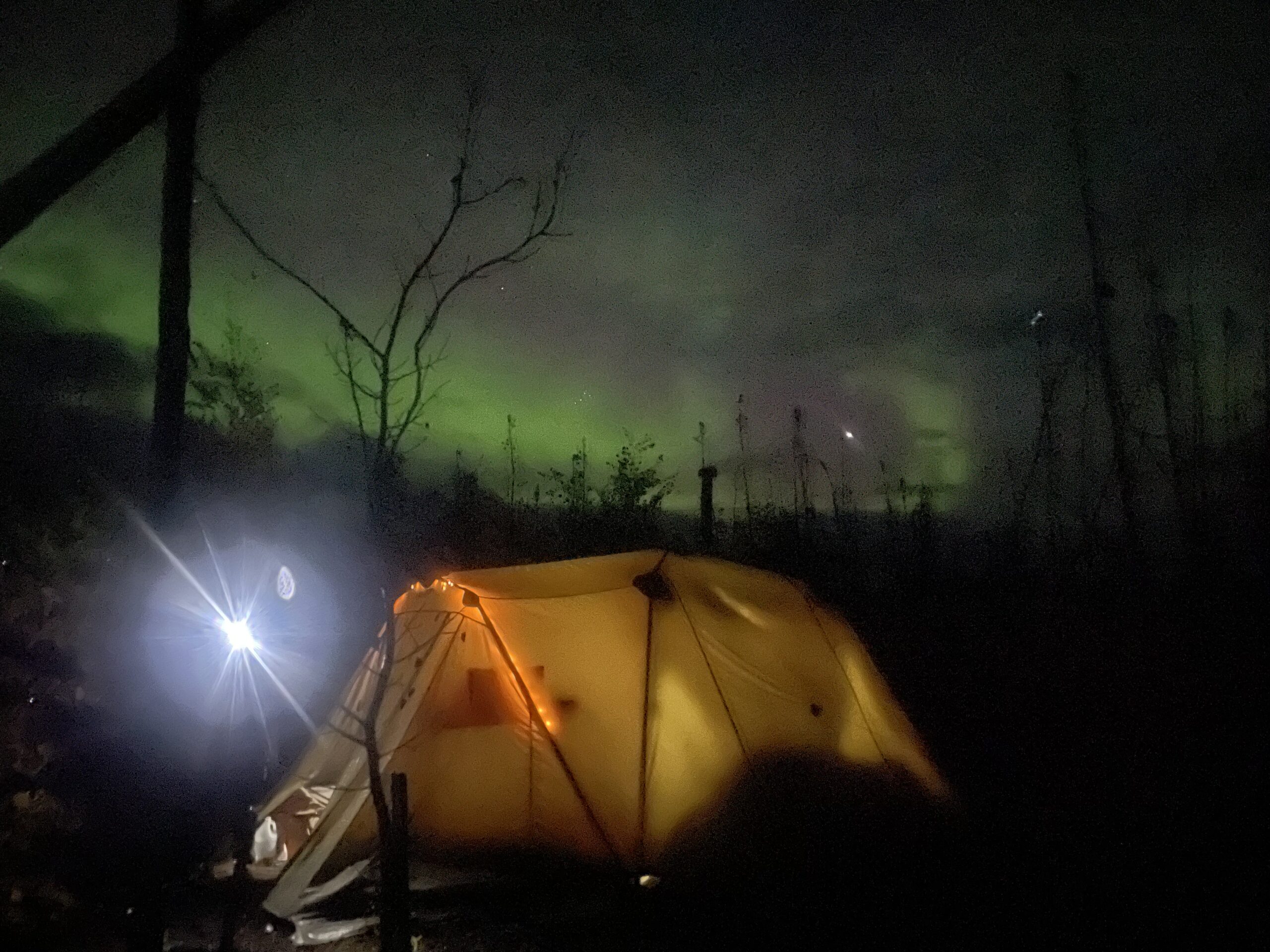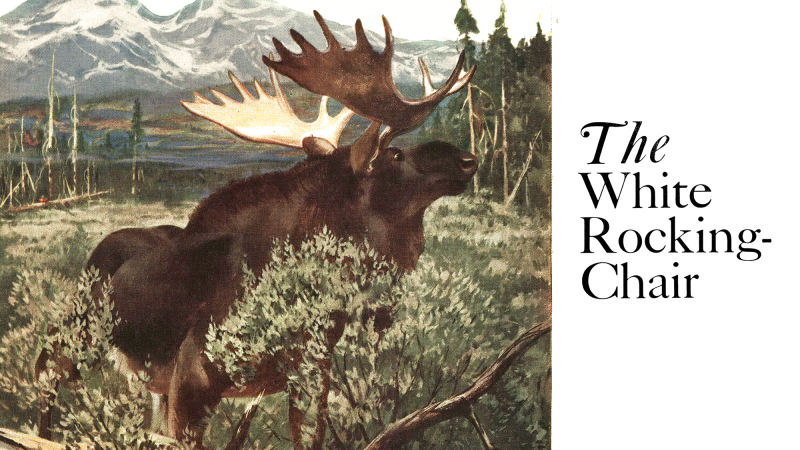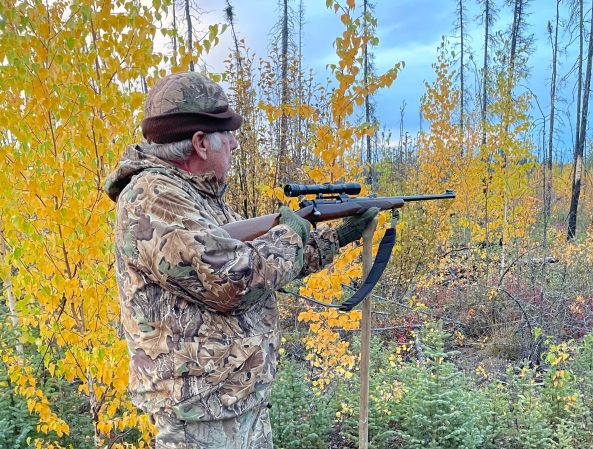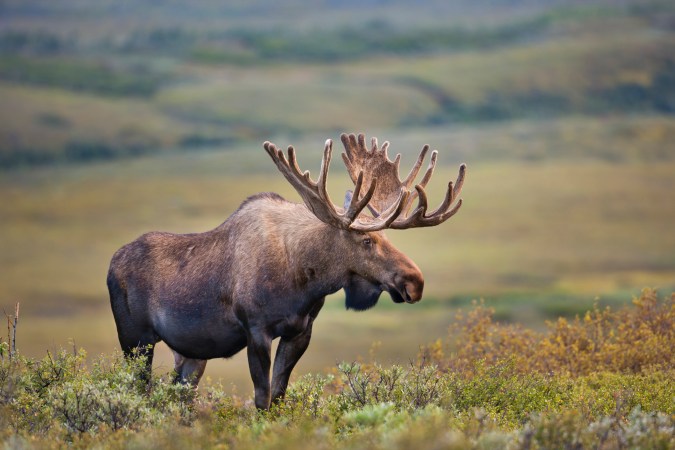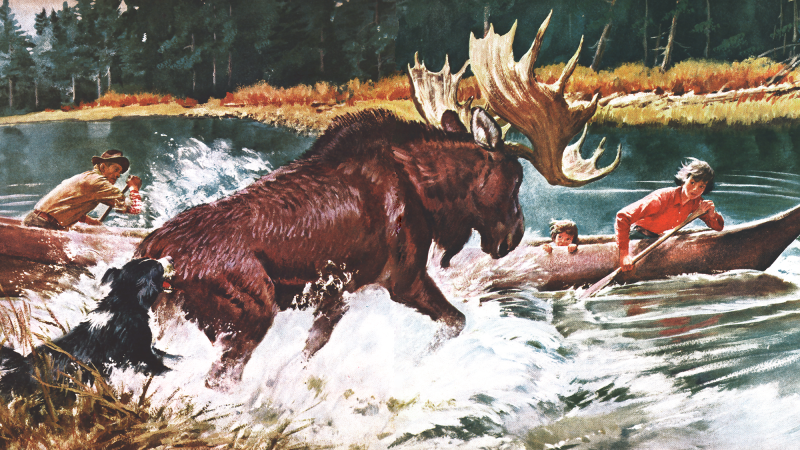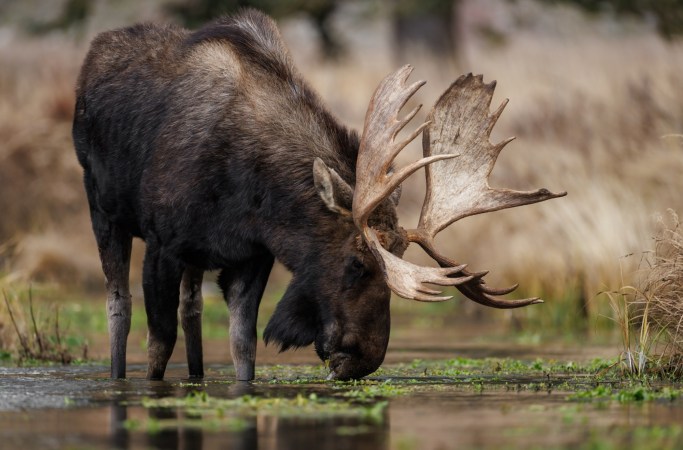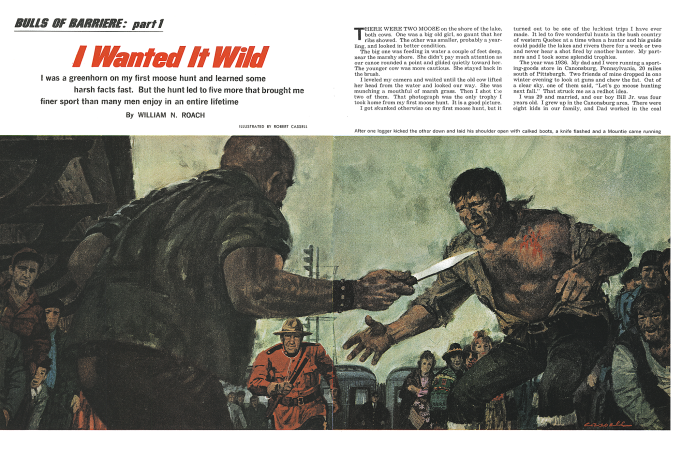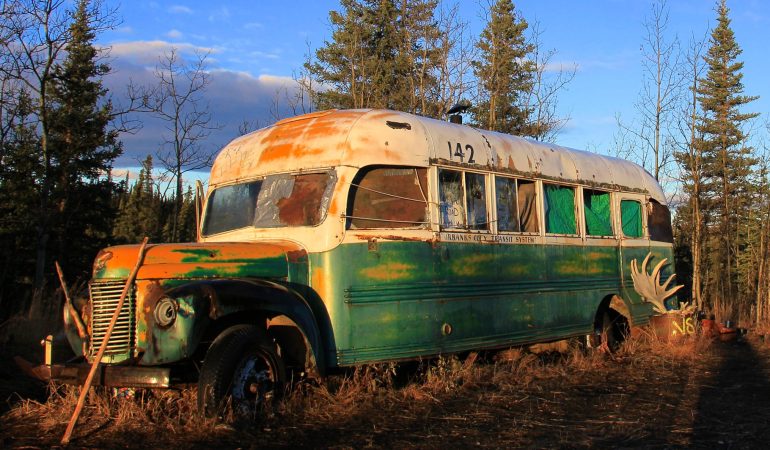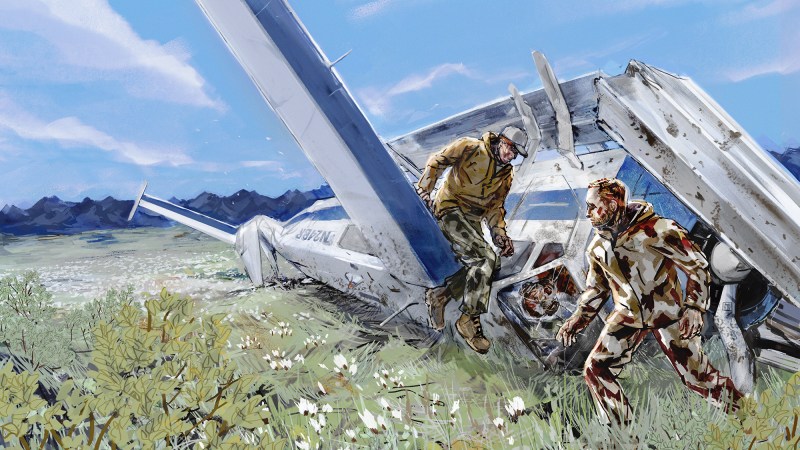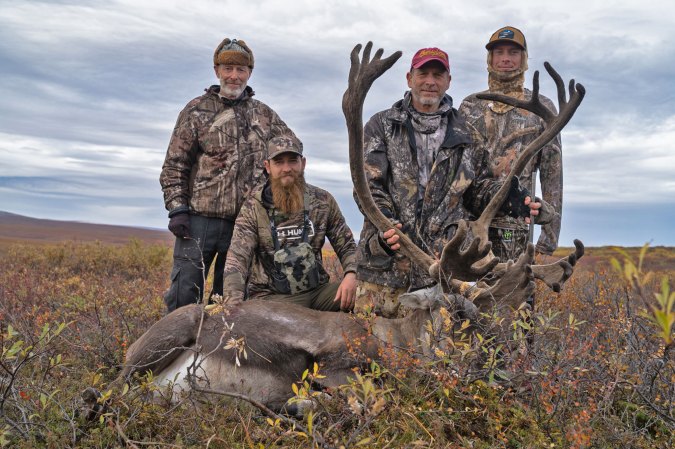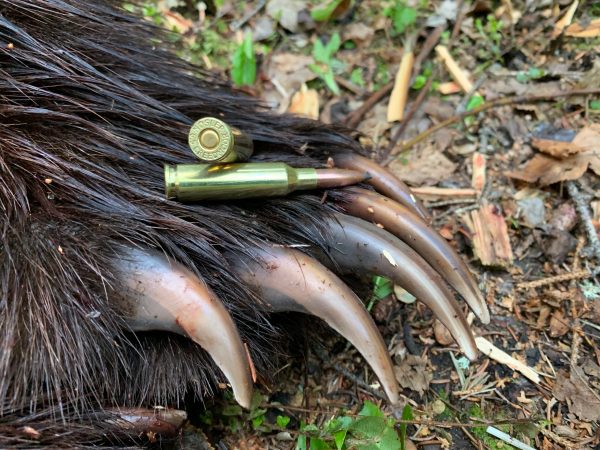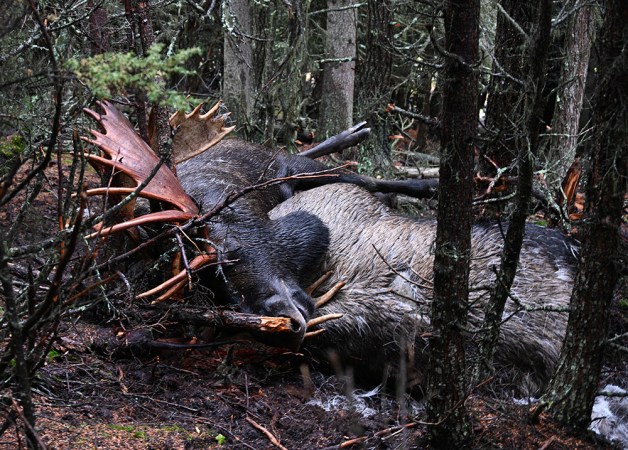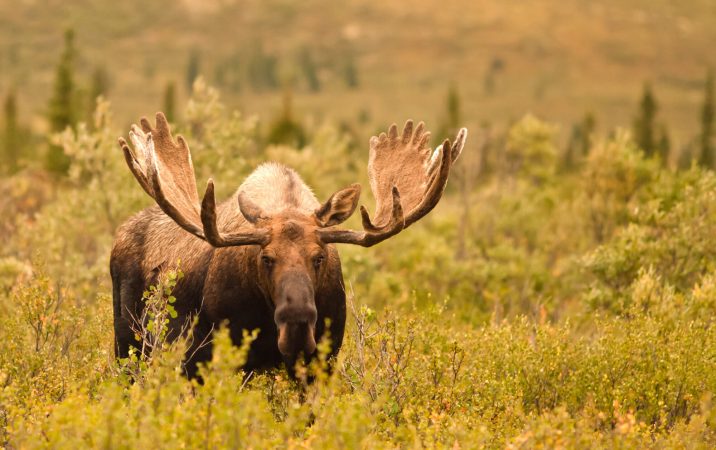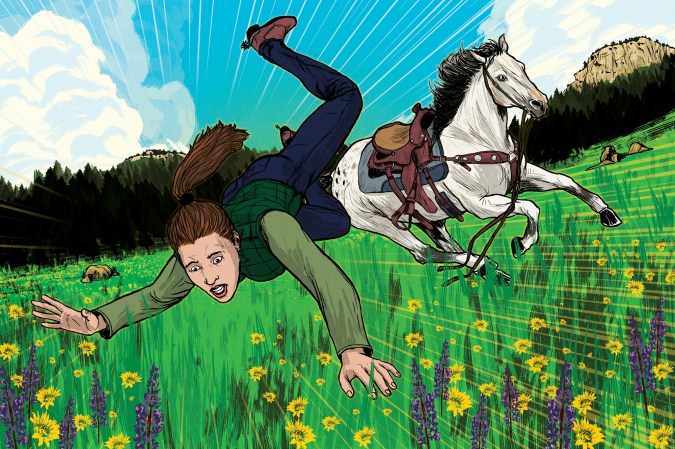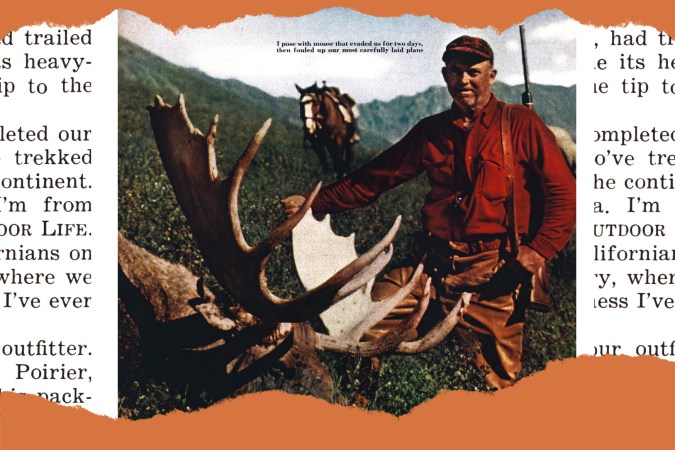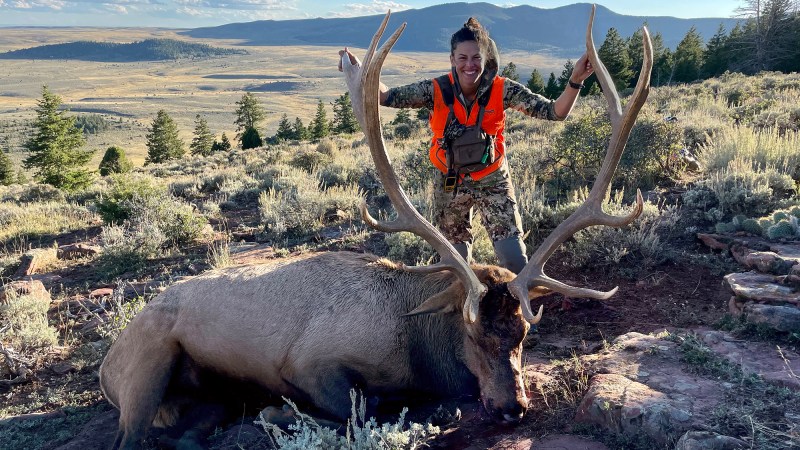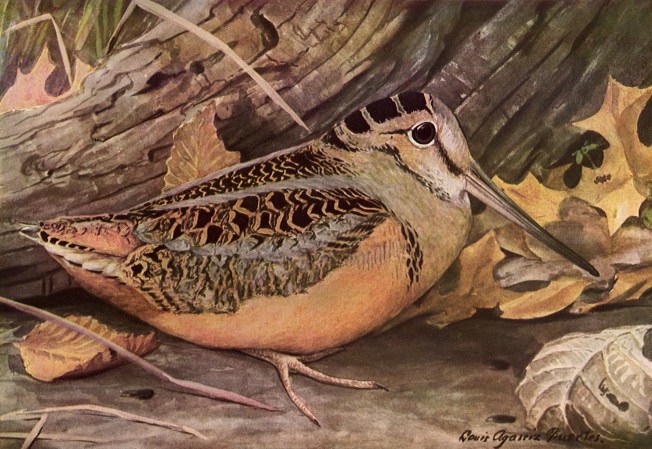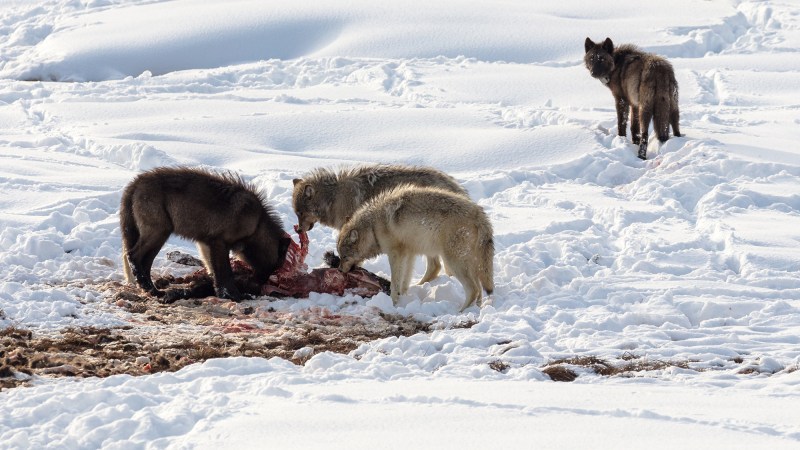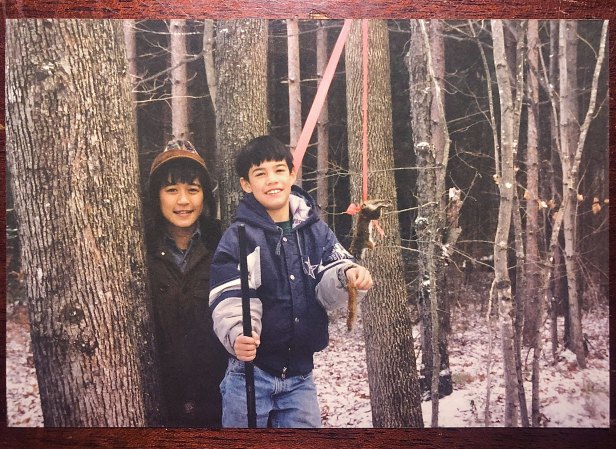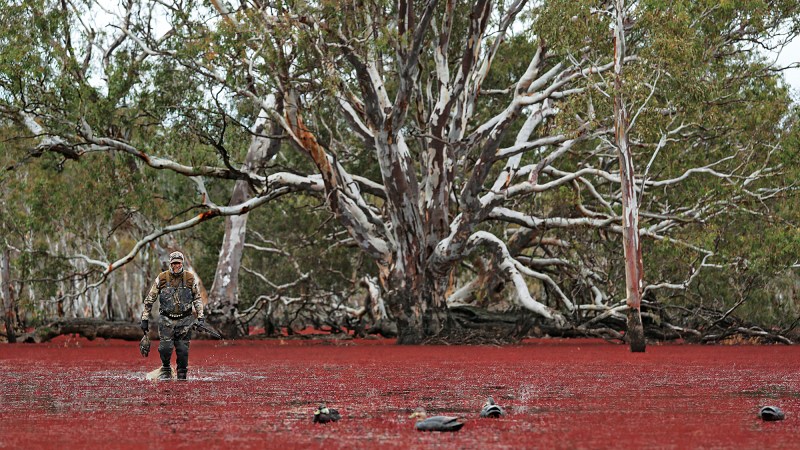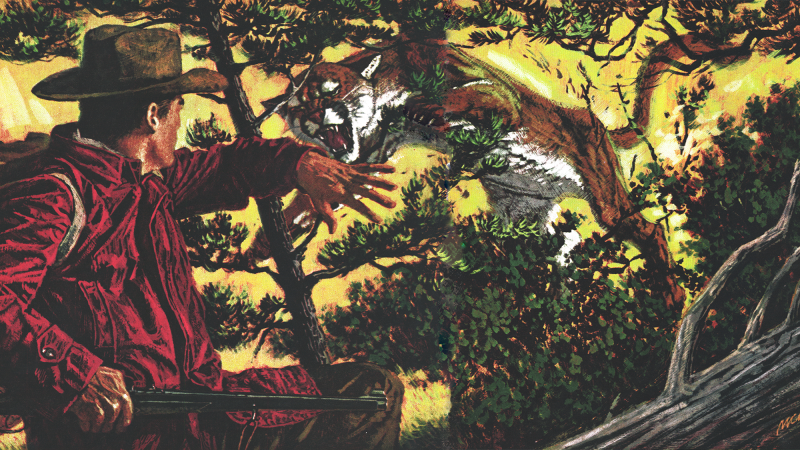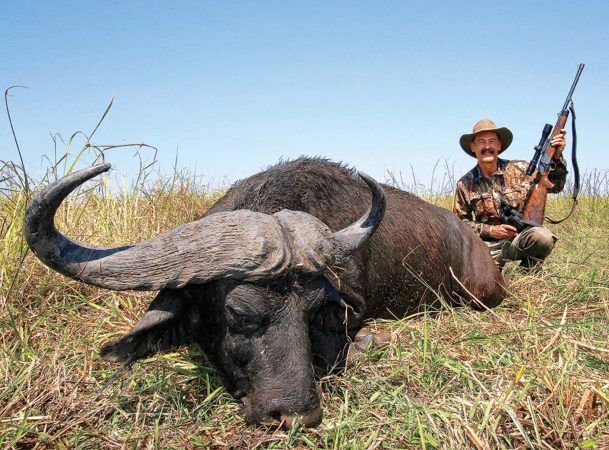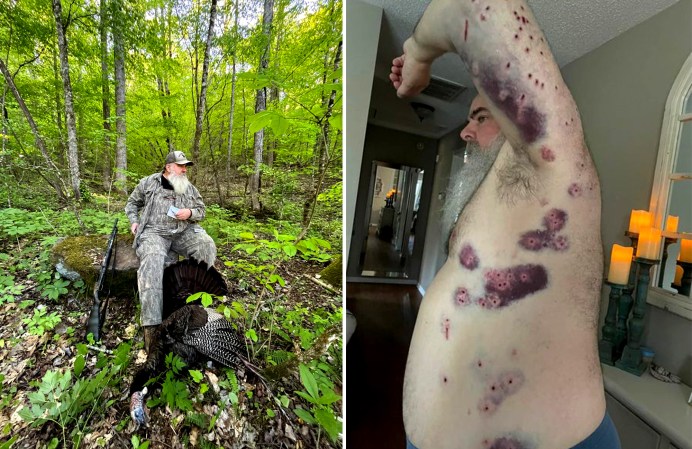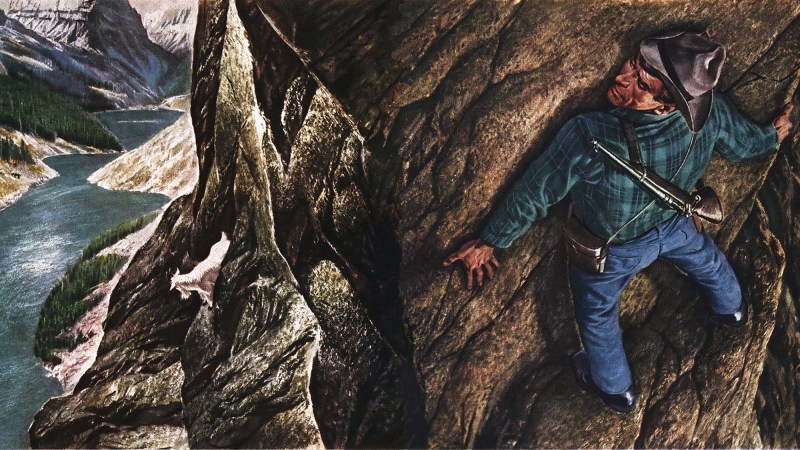I sighed in disgust at the wind I could hear whipping through the trees. My 5 a.m. alarm hadn’t been silenced for a minute, and I was already discouraged. Groggy and eyes blurry, I stuffed a few pieces of firewood into the stove. I squinted as I used my headlamp to illuminate the measuring lines in my Jetboil while pouring water for coffee. As the embers in the stove began to crackle, Frank set a pan on top of it with a pre-made breakfast sandwich for each of us: ham, cheese, and an egg, between halves of an English muffin. We ate and drank our coffee quietly. Nearly a week of early mornings had set our routine.
Our silence conveyed what we both knew, but left unsaid. The wind was probably going to kill our chances for a bull this morning. Still, moose hunting is partly about going through the motions and trusting the process. We dressed, put on our boots and, as light began to show on the horizon, we shouldered our rifles and began walking.
Setting Moose Camp
“There’s no way you’re moving that pile of shit anywhere,” Dave scoffed.
“You just watch, “ I told him as I climbed onto the four wheeler. In tow was a meat trailer, which had a 17-foot canoe lashed to the back. The trailer and canoe were brimmed with all manner of gear, food, and beer that was needed for a 10-day moose hunt in relative comfort. Dave Murray, a deer tracker from New England who was on his first trip to Alaska to come along on our moose hunt, just stood there as the wheeler chugged and began dragging the entire string of necessities and indulgences down the trail.
The days of preparing and shuttling gear were over, and the annual task of setting up camp was a sweet one. My hunting partner Frank Schultz and I have been camping and hunting in the same spot for several years now, and sitting down on my cot, it felt like we’d only ended last year’s moose hunt a day before.
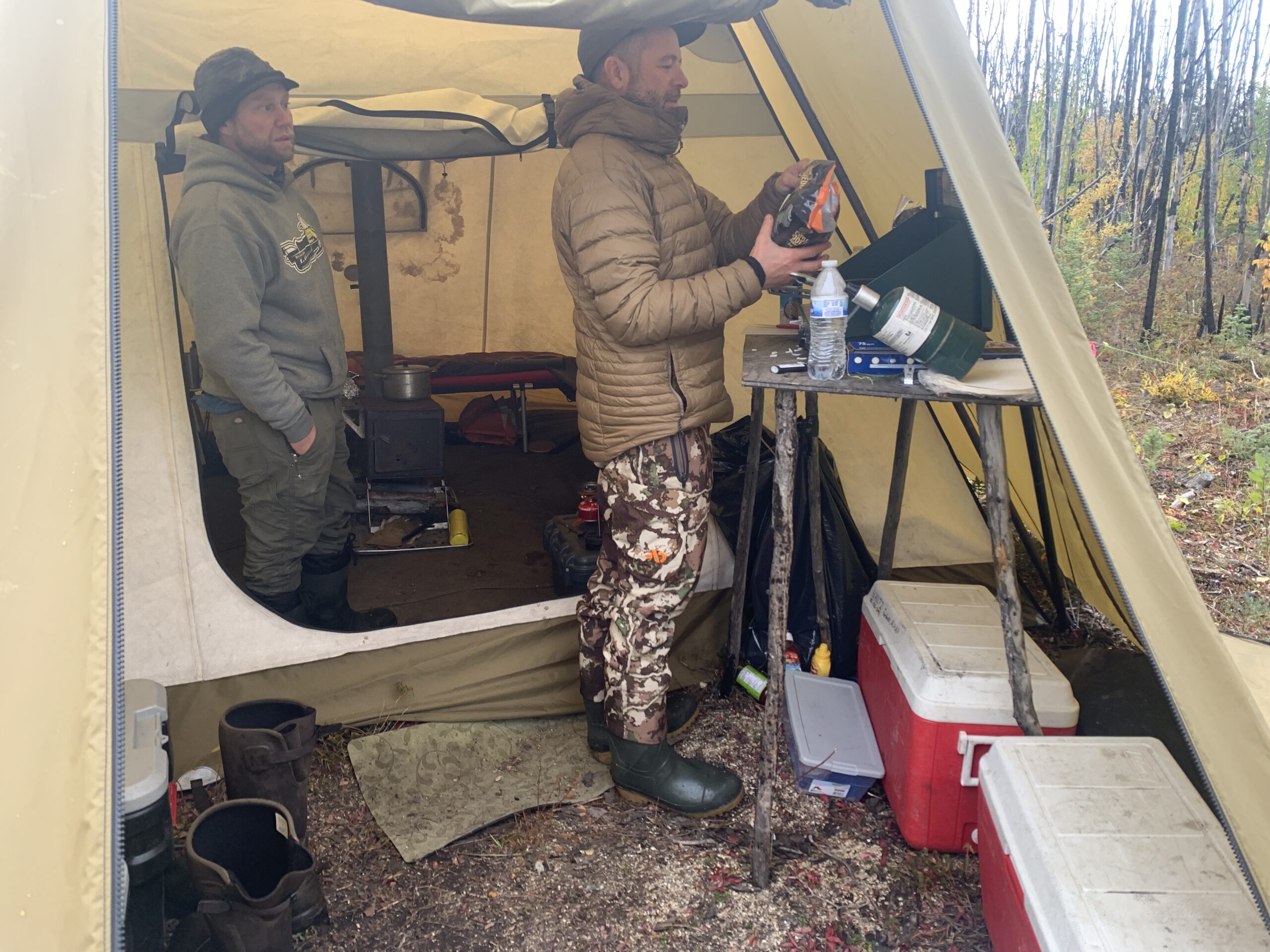
Moose camp is a welcome change of pace following a grueling August sheep hunt. Rather than finding ways to cut weight at the expense of comfort, we enjoy finding ways to make moose camp more palatable. The warmth of a wood stove and big daily breakfasts of sausage, eggs, hash browns, and pancakes dull the edge of a hunt that is an exercise in patience and quiet perseverance. A comfortable place to catch an afternoon nap and a percolator full of hot coffee makes it just a little easier to endure the hours of being still in the cold, listening for the faintest grunt or the sound of a bull raking his antlers, maybe miles away.
Moose Calling Is an Investment
When you’re calling moose, you might get an immediate response, but it’s just as likely that it will take days of projecting moose sounds to bring in a bull. It’s not that bull moose aren’t responsive—when the time is right, they’ll come to the sound of chainsaws and splitting firewood—but they are a low-density animal. Getting the right bull within earshot at the right time takes patience. Bull moose will come from miles away, but they need to be in the right mood, and not run into a more appealing moose on their way.
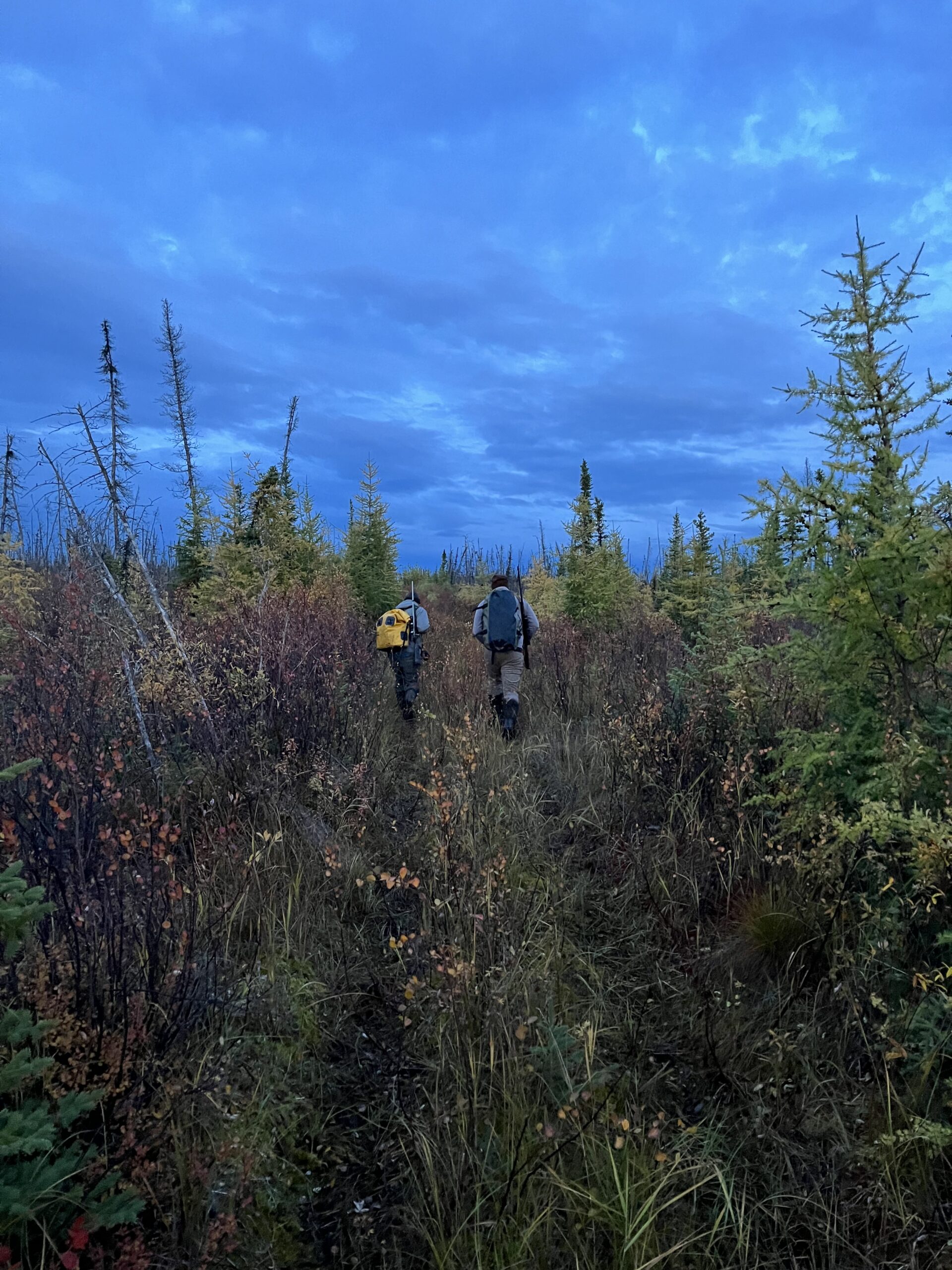
As we call for hours each morning and evening, we are hoping to call a bull that might be nearby, but also to catch the ear of a moose that might be two or three miles away. It can take days but we know that it will eventually work. Frank takes notes each year on what we hear and see—with a reminder to be patient and trust the calling. They will come, he has written in bold letters.
We were encouraged to hear bulls raking and grunting the first evening of our hunt, but they didn’t seem especially interested in our calls. With the entire hunt ahead of us, the grind of fruitless calling hadn’t yet worn on our nerves. Another bull grunting the following morning settled any worries that this could be the year our moose hole suddenly goes dry.
Each morning and afternoon we made the mile trek to a small patch of spruce and tamarack trees. We had set up a tripod stand to position the shooter above the sea of 7-foot-tall willows and dwarf birch. The sizable brush surrounding the stand shows the signs of being thrashed with a canoe paddle—each of a thousand strokes sending sound out into timber and swamps. Every one might be the stroke that catches a bull’s attention.
A Connection to the Past
Moose hunting, to me, is about much more than the anticipation and thrill of a rut-crazed bull pounding his way through the timber, inching closer and closer. Moose hunting and moose meat are generational staples for many of us here in Alaska. My uncle Jerry sometimes tells the story of the first time he ever tried a beef steak—when he was 17 years old. He and my dad often talk about my grandpa’s passion for moose hunting and how much they depended on the meat. My aunt Barb remembers the same thing.
“It seemed like all we ever ate was potatoes, moose, and caribou meat. I never even had macaroni and cheese till I was a teenager,” she told me.
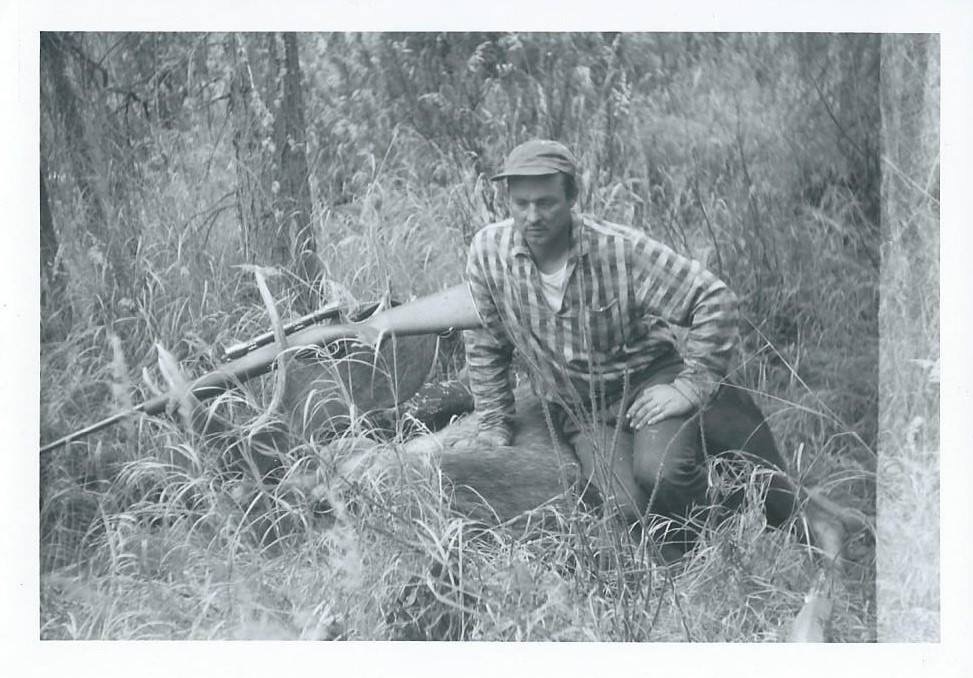
My grandpa and grandma moved to Alaska for good in the early 1950s, using his winnings from a poker game he got into when he, and the rest of the 82nd Airborne Division, finally got their paychecks at the end of World War II. With all his pockets stuffed with cash and a big pile on the table, he feared that the other battle hardened paratroopers would likely kill him before letting him go with their combat pay, so he made an escape plan. He left some cash on the table and snuck out the bathroom window. He slipped into the dark Bavarian night with $10,000 cash—a hefty sum in 1945.
As my uncle tells me, when Grandpa moved to Alaska, he brought a new Remington Model 721 chambered in .300 H&H Magnum. He killed many moose and caribou over the years with that Super .30, and passed it on to my uncle Jerry when he was a teenager. My uncle went on to kill many more moose, caribou, sheep, and bears with that gun, and when Jerry gave me the rifle last year, I knew that I had to kill a moose with it too.
A New Touch on an Old Rifle
At some point, my uncle had that old Model 721 re-stocked, and the butt of the grip has his initials carved in it: JF. The old blued barrel and receiver show the sort of shiny wear that only time and use can produce. The old Redfield wide-view scope was bent, so I replaced it with a Leupold VX6HD scope.
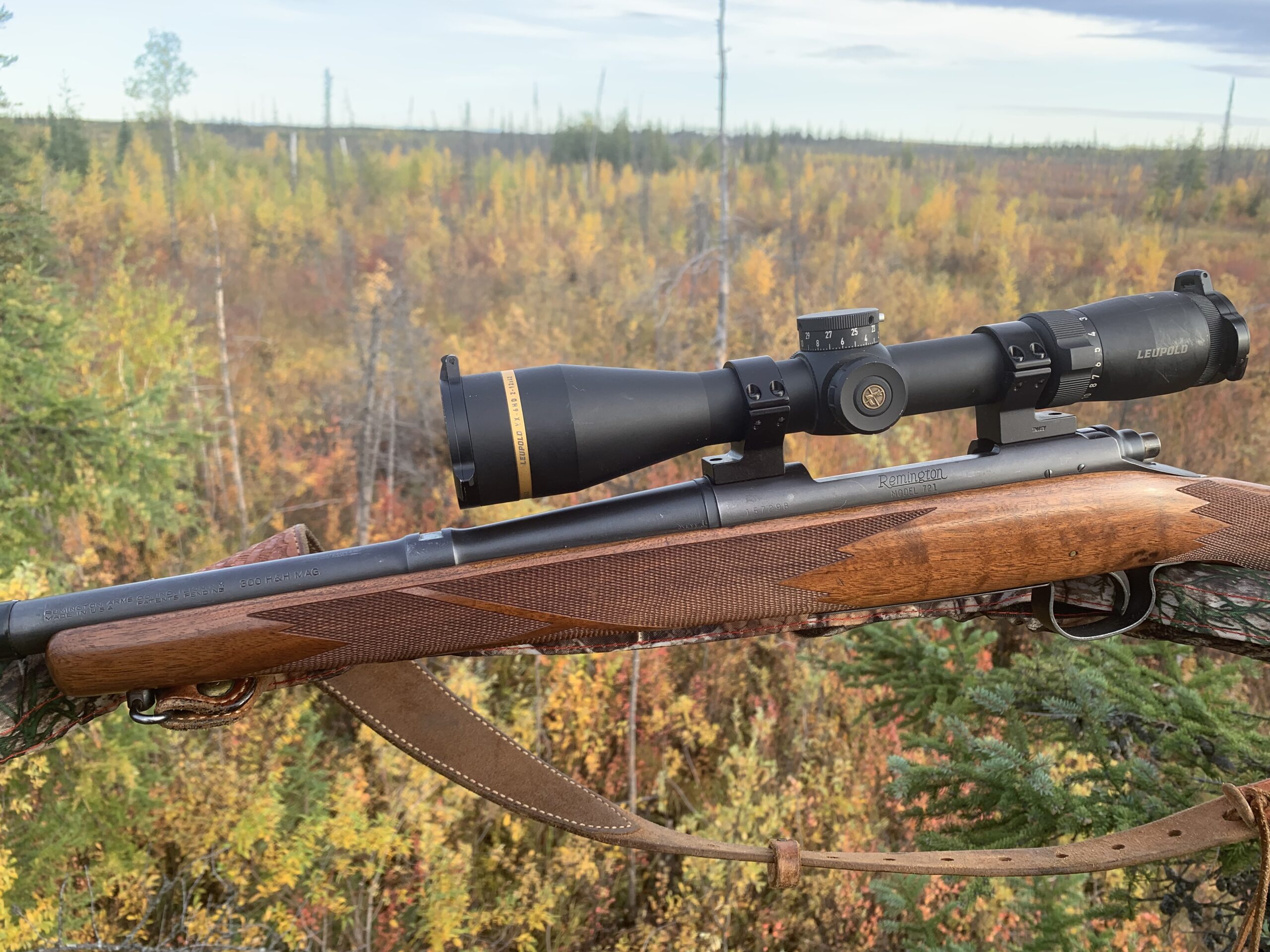
My uncle had given me a couple boxes of old Federal Premium factory loads that shot 180-grain Nosler Partitions very well, but being a reloader, I couldn’t leave well-enough alone. I ordered a hundred pieces of shiny new Nosler .300 H&H brass and worked up a load using Lehigh Defense 175-grain Controlled Chaos bullets atop the classic IMR 4350 powder. I didn’t push the 72-year-old rifle for good, hard accuracy data, but five-shot groups printed about an inch, at an average of 3,045 feet per second.
The Doldrums
Where we hunt moose, we must depend completely on calling them to us. The country is moose-rich, but pitiful for a would-be wanderer. The country is a mix of flats and low hills. Any hill one might consider a good vantage point is so choked with fallen burnt timber and 10-foot-high re-growth that it’s even worse than the low country. Even if you have the good fortune to spot a moose a mile away, the thick, swampy country will rarely allow you to close the distance. Kill a moose a mile or two from your equipment? You’ve got hell to pay. And so we call, and wait.
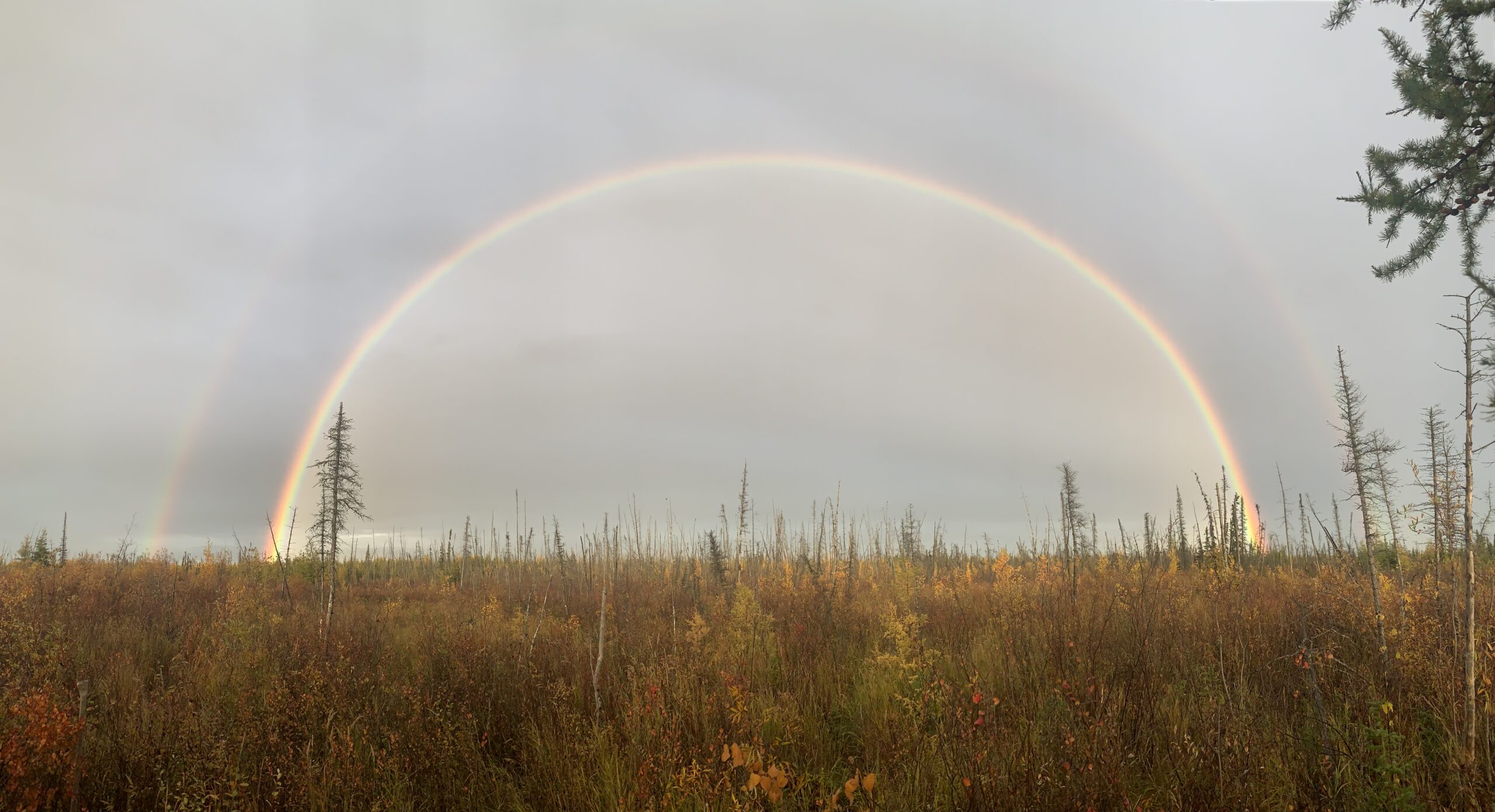
We begin each morning by raking brush with a canoe paddle to simulate a bull scraping his antlers, adding a few soft grunts into the mix. We do this every 20 minutes or so, slowing the interval gradually until we stop calling mid-morning. In the late afternoon we start calling at 30- to 45-minute intervals and shorten them as darkness approaches. After about the 15th of September, we start mixing cow calls into our sequence. If we get a bull to respond, we start calling directly to him.
It’s typical to hear the response of a bull or two per day, but it takes time, patience, and circumstance to tie into the right moose’s ear at the right time. We start hunting at a time when bulls are starting to become responsive, then become very responsive for about 5 days before they lock up with cows, seemingly overnight. It gets damn tough after that. We never see most of the moose we hear, but it’s easy to let doubt creep in when all is silent.
Until this year, we’d only gone a day and a half without hearing a bull, but after an encouraging start to our hunt, we went nearly four days only hearing a single series of moose grunts. That’s nearly 36 hours of actively calling. “Trust the calling, they will come,” Frank read his notes aloud as we packed up to walk back to camp in the dark, calm night. “It will work.”
Bad Luck Dave
Despite being confined to a single spot rather than following tracks day after day, Dave was doing well—except he was getting sick. We teased him at first, but soon could tell that he had more than just a little cough. It didn’t help that we goaded him about being bad luck. When we woke up on the sixth morning of our hunt, the wind whipping through the trees, we didn’t think much of letting him take a morning off—he wouldn’t miss much. A key principal of calling moose is that they have to hear you, which is tough in the wind. We’d also never killed a moose in the morning out there.
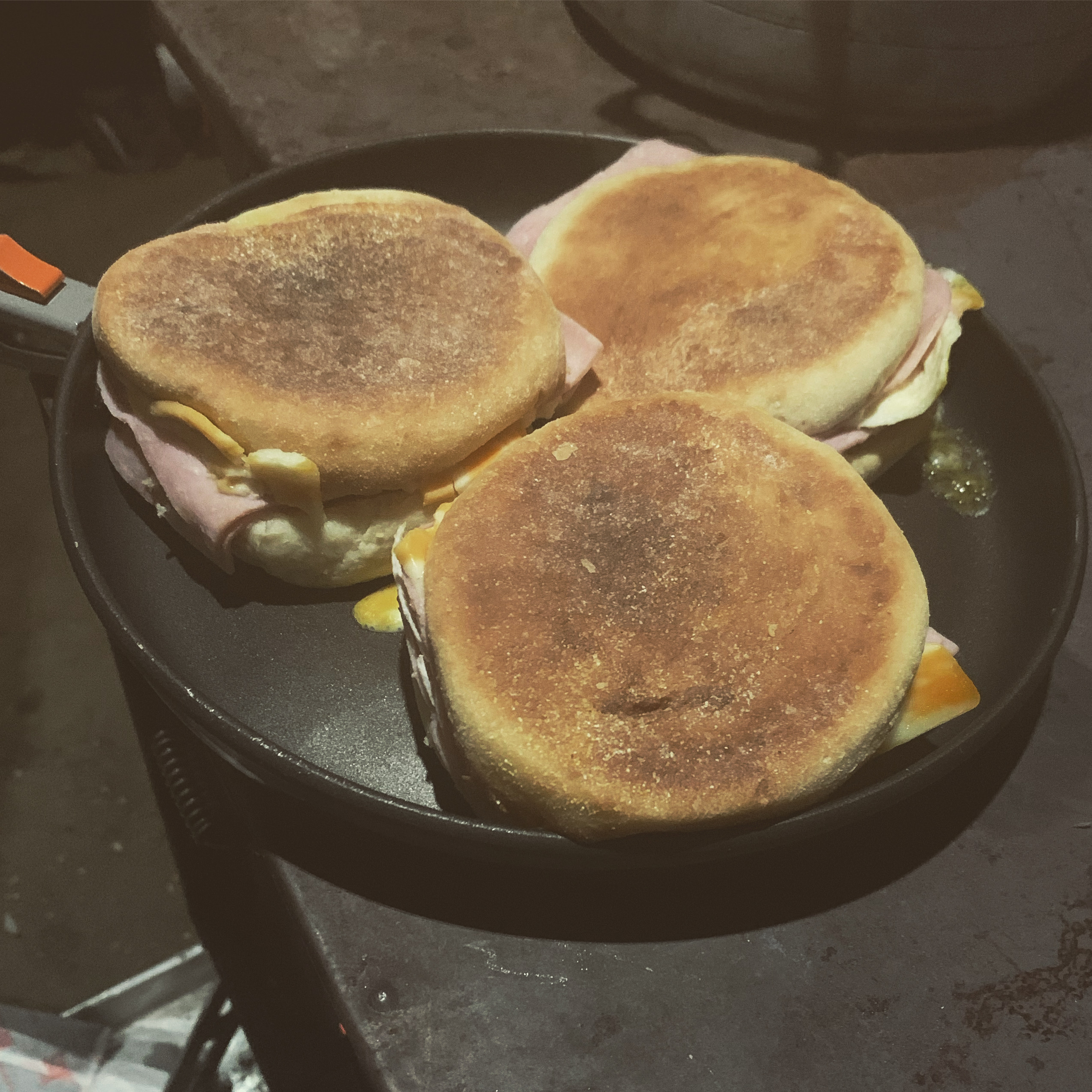
Frank and I walked quietly down the trail, both of us cussing the wind under our breath. It wasn’t great, but we felt that we had to punch the clock anyway. We retrieved our warm clothes from backpacks by headlamp and quietly prepared for a breezy, chilly morning. I climbed the cold steel rungs of the stand’s ladder and set my rifle across the hexagonal shooting rail. Go for it, I nodded to Frank as I peered into the dissipating darkness. He picked up the canoe paddle and gently raked the brush. Then he cut loose with a nasally, whining cow call—we never start cow calling much until the 16th of September, which was today.
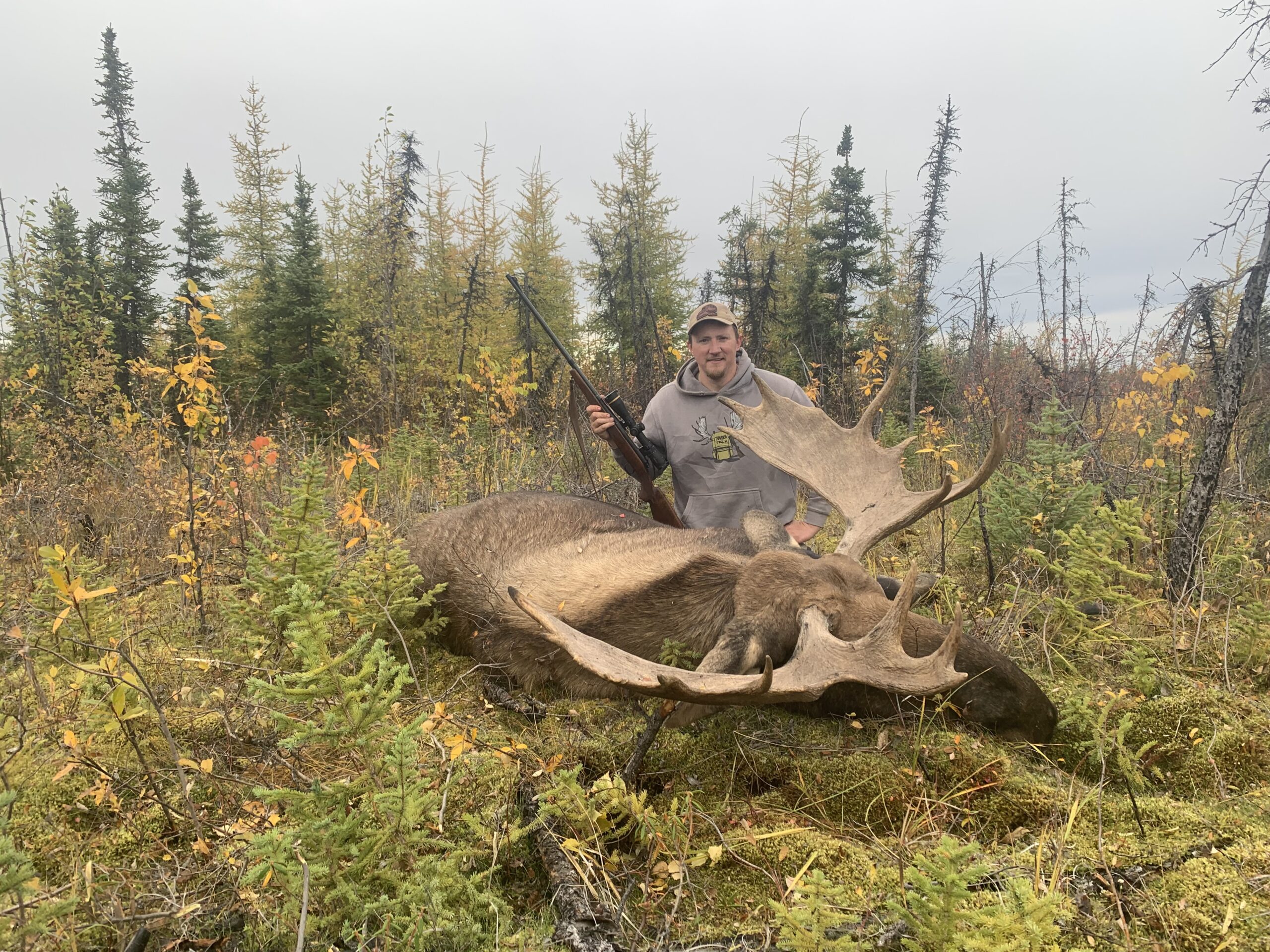
“PSSSST!”
I turned and looked down.
“There’s a bull right over there, close!”
He was pointing in the opposite direction of where I’d been looking. With my head 20 feet up in the wind, I couldn’t hear the bull tearing the hell out of the brush before Frank even cut off his cow call. Now I could hear him grunting though. I drew the bolt back on that old rifle and slipped an extra round into the chamber, closing the bolt back over a full magazine. I could hear the steady beat of his low-pitched grunts, and within seconds I could see him—a dark shadow moving through a stand of burnt timber, less than a hundred yards away.
I quickly looked with binoculars and saw decent-sized paddles. That was good enough for me. I hadn’t killed a moose the year before, and we needed the meat. The bull steadily walked through the scrubby timber around us and I lined my scope up on him to make sure I could see well enough. I could barely see him with the naked eye in the pre-dawn light. There are no legal shooting hours, so if you can see well enough to shoot, you can.
As the bull continued to circle us, trying to get our wind, he walked out of a patch of thick black spruce and into an open flat, about a hundred yards away. I quickly set my little shooting bag atop the rail and lined up on the plodding bull in the scope. I scanned ahead of him and found a clear opening in the low brush. As he stepped into it, I cut a shot loose right behind his shoulder. He stopped and stood still. I quickly cycled the rifle and fired again. The bull stood still. While considering a third round, I saw the bull begin to sway—all typical behavior for a bull that’s just been fatally shot.
“Down he goes!” I said to Frank.
“I knew you got him good when I could hear the air coming from his chest, but I can’t see a damn thing,” he replied.
We walked over to check on the bull, and we were on our way back to the tent before the sun had cracked over the horizon.
“I guess Dave doesn’t get to sleep in,” Frank said.
“Yeah,” I added, “maybe he was bad luck after all.”
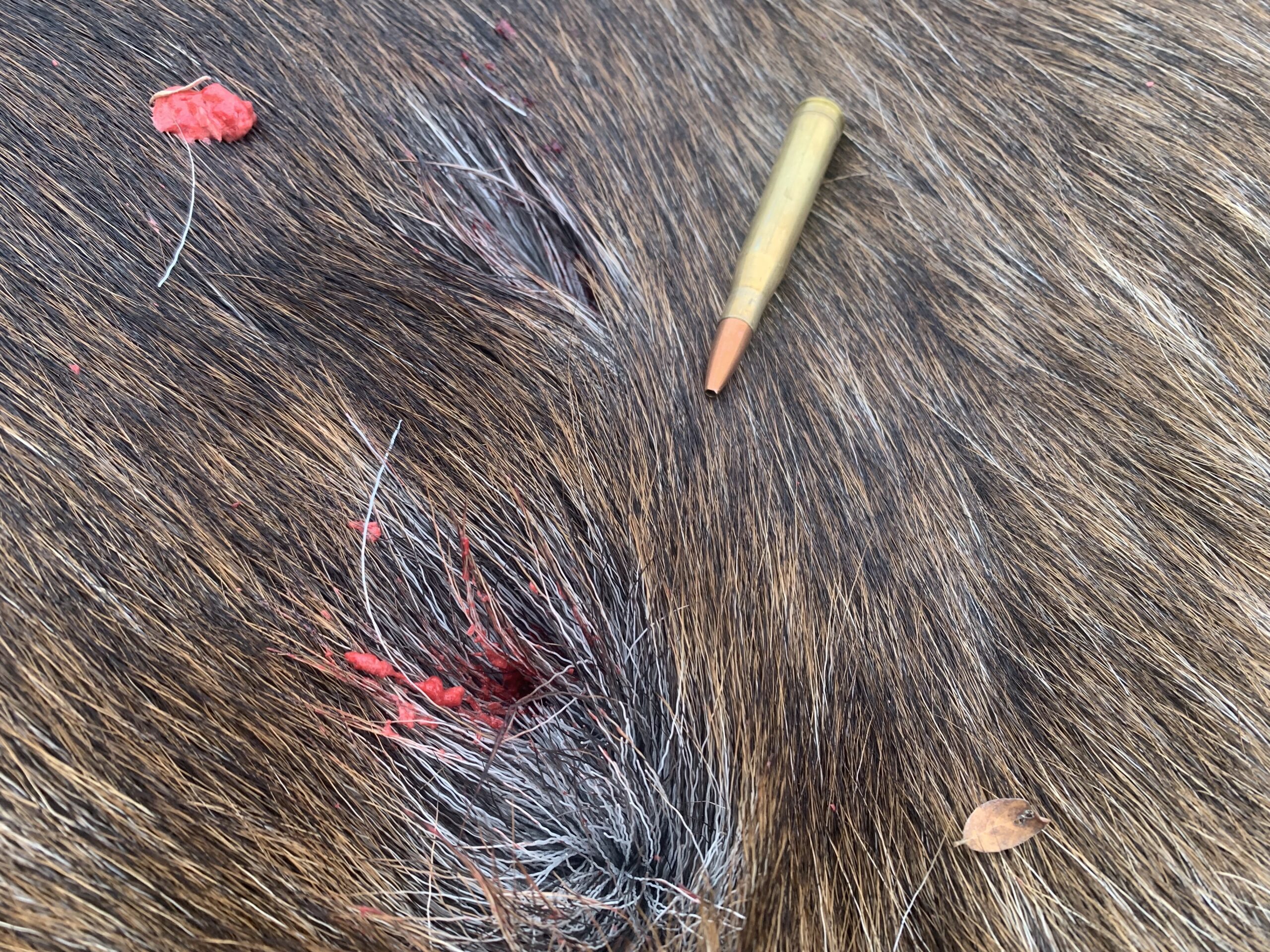
Morning Moose
Dave hadn’t heard us shoot, but he knew what had happened when we showed up at the tent. We made a big pot of coffee and some more breakfast as we recounted the story and how quickly it had happened. We had walked right by the bull on our way to the stand, and the wind was likely a blessing in disguise, concealing the sound of our movement. He must have been bedded down after coming to our calling the previous night.
Whatever the matter, the outcome was welcome. We had good weather and something that any seasoned moose hunter appreciates: a wonderfully flat, dry spot to cut up the bull and get him out. We’d butchered all our other moose by headlamp each year, and the chore was enjoyable in the daytime. Hundreds of pounds of pristinely clean meat was a pleasure to break down.
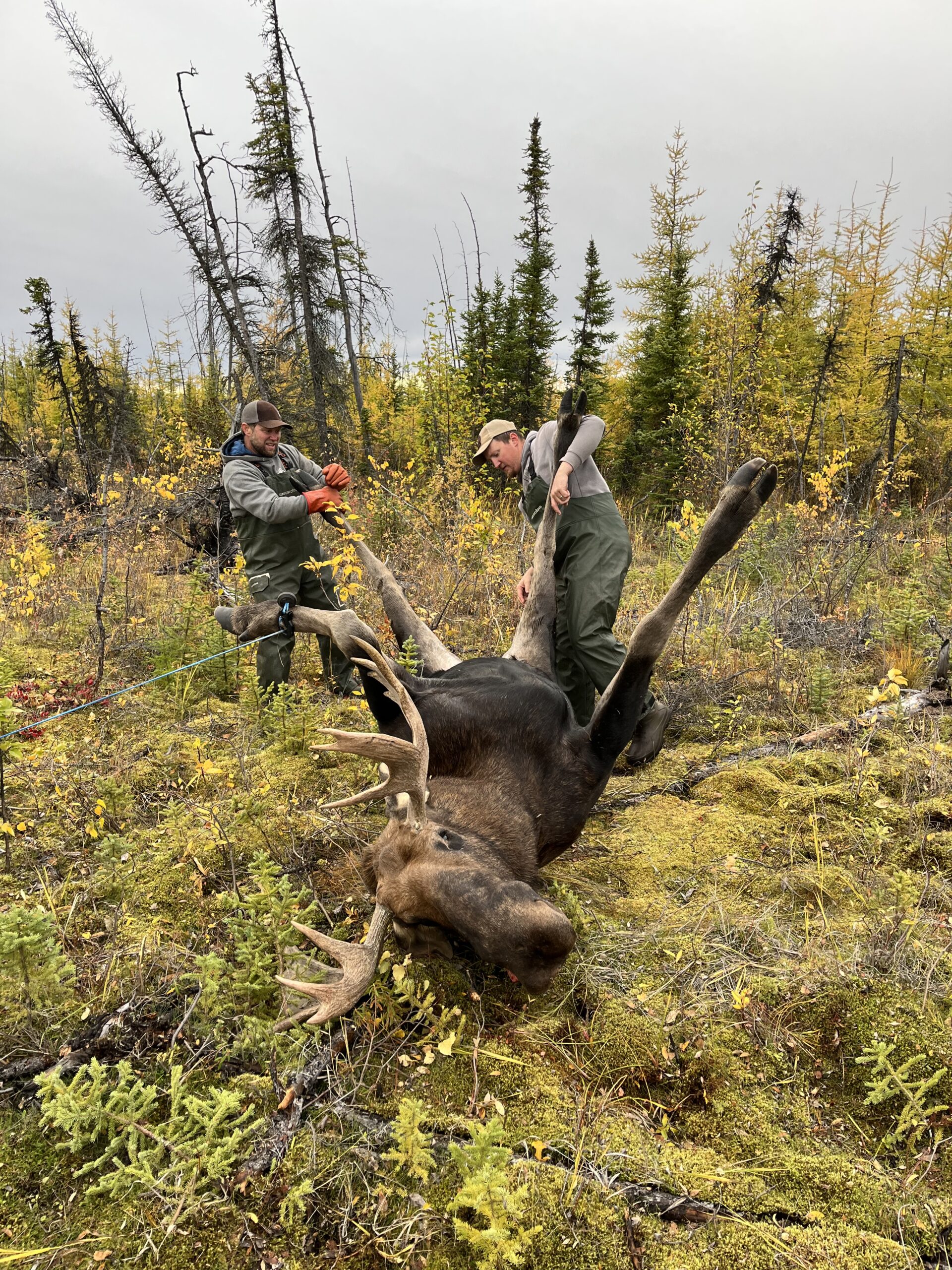
Every Moose Season Must End
After hanging up the meat from my bull we returned in the evening and heard three other bulls grunting and raking—a sure sign that rut activity was starting to pick up. Still, the bulls are constantly moving, and things got quiet again. We spent a few days calling before Frank passed a smaller bull one rainy evening
On the morning of Sept. 21, it was as if a switch had been flipped. We heard bulls everywhere—but we heard cows with most of them, too. We did have one bull riled to a frenzy, raking and glucking his heart out as he came closer and closer. It wasn’t to be, though. He veered toward another bull and cow. No matter your effort, the sweetest cow call in the world won’t get a bull to leave the real thing.
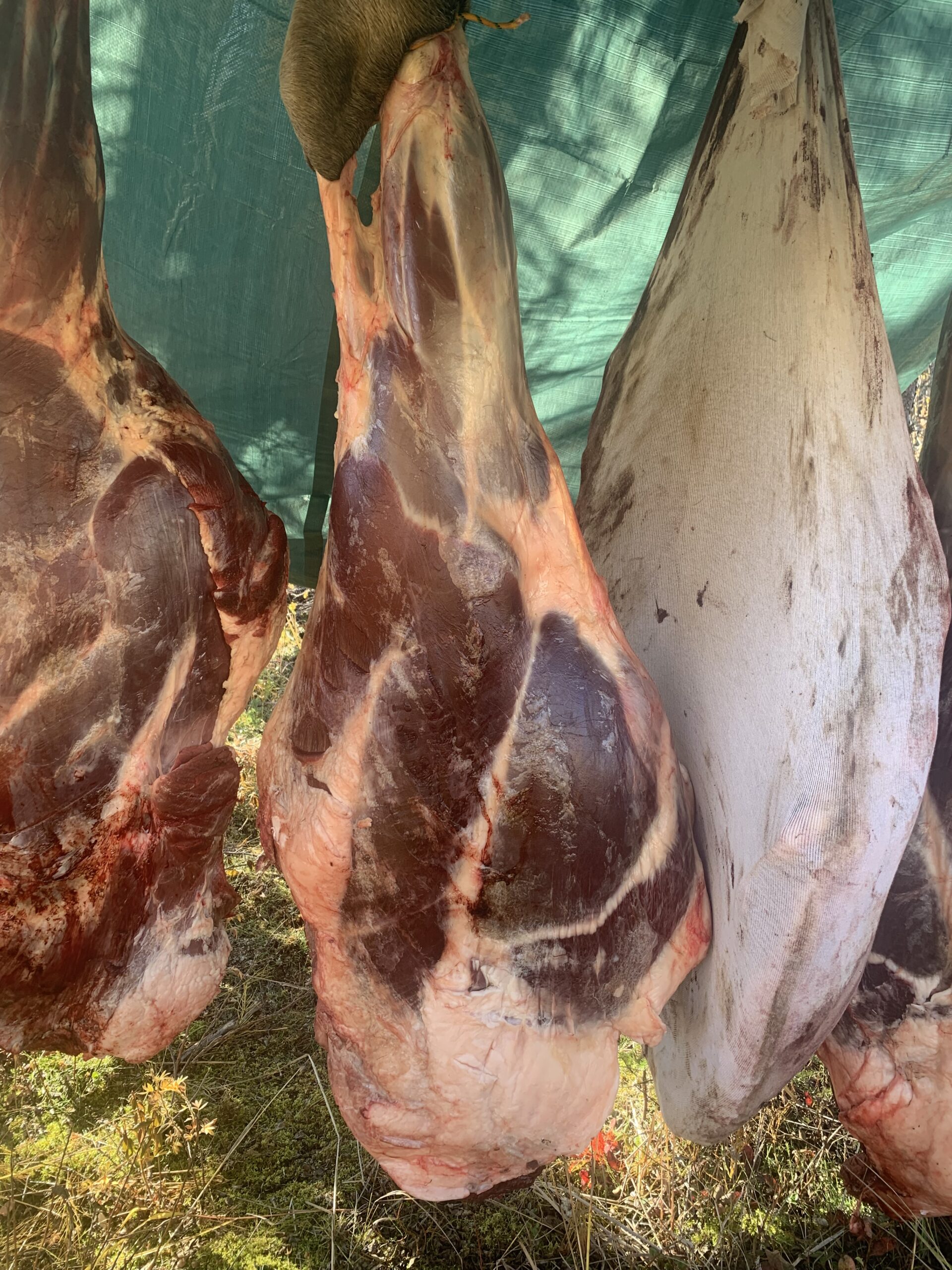
Read Next: Top Moose Hunting Cartridges
We began the arduous task of hauling the meat and camp back out, and it seemed that as quickly as moose season had followed the busy Alaskan summer, it was gone again.

